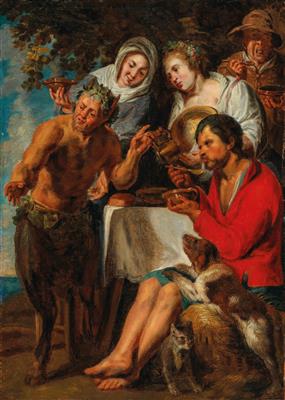Jacob Jordaens

(Antwerp 1593–1678)
The Satyr and the Peasant Family,
oil on panel, 71 x 50.5 cm, framed
Provenance:
Private collection, Belgium, 1918;
sale, Antiek Kompaniet, Gothenburg, April 1920, lot 7;
Private collection, Scandinavia;
sale, Bukowskis, Stockholm, 25 November 2009, lot 352;
sale, Hampel, Munich, 10 December 2015, lot 273;
Private European collection
The present panel is a mature treatment of one Jordaens’s most favoured profane themes of his career, depicts one of Aesop’s fables - the visit of a Satyr to a peasant’s dining table (Aesop LXXIV). The current vibrant treatment of the story, which so appealed to Jordaens’s sense of moralising wit, without being too obviously didactic, exists in at least five versions. The prime version circa 1616-1618 is conserved in the Glasgow Museum and Art Gallery. Contemporaneous with the Glasgow picture was the publication of Joost van der Vondel’s 1617 work, Vorstelijke Warande der dieren or ‘The Princely Pleasure-Grounds of Animals’ transposing Aesop into rhyming couplets, which recounts the episode:
‘One winter a farmer found a satyr wandering in the wood, The satyr is half man on top, at the bottom a goat, He decided to shelter him lest he died of cold; He brought him home and made him good cheer, When the man blew on his hands to warm them he took note, Asking him why the peasant replied, “I am warming my knuckles all stiff from the wintery cold;” When the peasant also blew on his hot food, laid out on a rough board, The satyr, rather confused, wondered at this, Apprehensive, he flew out of the door in fear of his life, Because he perceived the peasant could blow both hot and cold. For as the saying goes, ‘The Wise man always shows love and goodwill, Towards him that holds fire in one hand and water in the other, In order to avoid his evil sorcery’.
Jordaens’s popularising of the composition, which humorously warns against inconstancy, led to further treatment of the subject, by the Leiden master Jan Steen (see ‘The Wise Man has two tongues: Images of the Satyr and the Peasant in Jordaens and Steen’ in Myth in History, History in Myth, Boston 2009, p.87 & ff. 4.) The present picture a later treatment by Jordaens from around the 1630s or 1640s, still uses the pyramidal arrangement of figures and dynamic lighting apparently inspired by Caravaggio’s Madonna of the Rosary (Vienna, Kunsthistorisches Museum), which was reputedly brought to Antwerp by Louis Finson and purchased by a consortium that included Jordaens’s friend Peter Paul Rubens.
A dendrochronological examination by Peter Klein, Hamburg, concludes a felling date for the oak tree from which the panel is constructed of circa 1630/35.
Expert: Dr. Alexander Strasoldo
 Dr. Alexander Strasoldo
Dr. Alexander Strasoldo
+43 1 515 60 403
old.masters@dorotheum.com
10.11.2020 - 16:00
- Odhadní cena:
-
EUR 80.000,- do EUR 120.000,-
Jacob Jordaens
(Antwerp 1593–1678)
The Satyr and the Peasant Family,
oil on panel, 71 x 50.5 cm, framed
Provenance:
Private collection, Belgium, 1918;
sale, Antiek Kompaniet, Gothenburg, April 1920, lot 7;
Private collection, Scandinavia;
sale, Bukowskis, Stockholm, 25 November 2009, lot 352;
sale, Hampel, Munich, 10 December 2015, lot 273;
Private European collection
The present panel is a mature treatment of one Jordaens’s most favoured profane themes of his career, depicts one of Aesop’s fables - the visit of a Satyr to a peasant’s dining table (Aesop LXXIV). The current vibrant treatment of the story, which so appealed to Jordaens’s sense of moralising wit, without being too obviously didactic, exists in at least five versions. The prime version circa 1616-1618 is conserved in the Glasgow Museum and Art Gallery. Contemporaneous with the Glasgow picture was the publication of Joost van der Vondel’s 1617 work, Vorstelijke Warande der dieren or ‘The Princely Pleasure-Grounds of Animals’ transposing Aesop into rhyming couplets, which recounts the episode:
‘One winter a farmer found a satyr wandering in the wood, The satyr is half man on top, at the bottom a goat, He decided to shelter him lest he died of cold; He brought him home and made him good cheer, When the man blew on his hands to warm them he took note, Asking him why the peasant replied, “I am warming my knuckles all stiff from the wintery cold;” When the peasant also blew on his hot food, laid out on a rough board, The satyr, rather confused, wondered at this, Apprehensive, he flew out of the door in fear of his life, Because he perceived the peasant could blow both hot and cold. For as the saying goes, ‘The Wise man always shows love and goodwill, Towards him that holds fire in one hand and water in the other, In order to avoid his evil sorcery’.
Jordaens’s popularising of the composition, which humorously warns against inconstancy, led to further treatment of the subject, by the Leiden master Jan Steen (see ‘The Wise Man has two tongues: Images of the Satyr and the Peasant in Jordaens and Steen’ in Myth in History, History in Myth, Boston 2009, p.87 & ff. 4.) The present picture a later treatment by Jordaens from around the 1630s or 1640s, still uses the pyramidal arrangement of figures and dynamic lighting apparently inspired by Caravaggio’s Madonna of the Rosary (Vienna, Kunsthistorisches Museum), which was reputedly brought to Antwerp by Louis Finson and purchased by a consortium that included Jordaens’s friend Peter Paul Rubens.
A dendrochronological examination by Peter Klein, Hamburg, concludes a felling date for the oak tree from which the panel is constructed of circa 1630/35.
Expert: Dr. Alexander Strasoldo
 Dr. Alexander Strasoldo
Dr. Alexander Strasoldo
+43 1 515 60 403
old.masters@dorotheum.com
|
Horká linka kupujících
Po-Pá: 10.00 - 17.00
old.masters@dorotheum.at +43 1 515 60 403 |
| Aukce: | Obrazy starých mistrů |
| Typ aukce: | Sálová aukce s Live bidding |
| Datum: | 10.11.2020 - 16:00 |
| Místo konání aukce: | Wien | Palais Dorotheum |
| Prohlídka: | 04.11. - 10.11.2020 |
